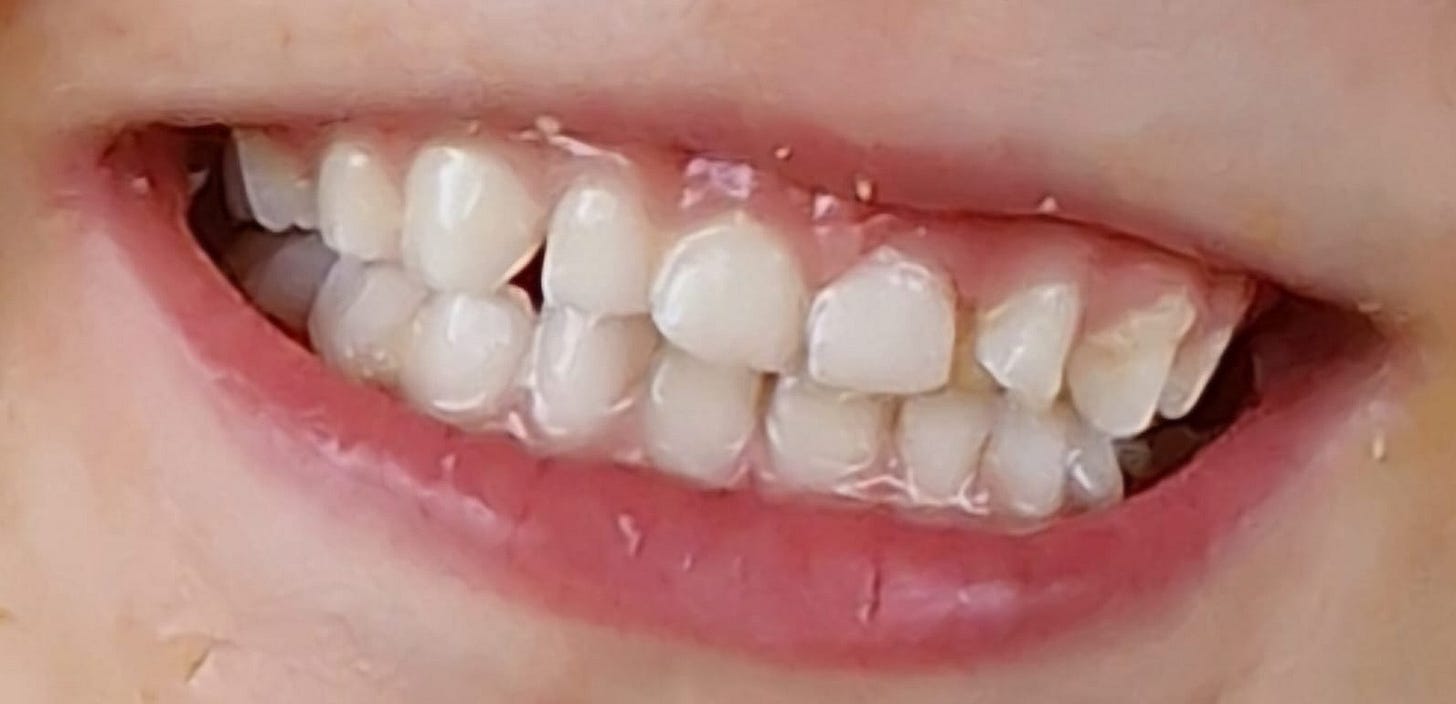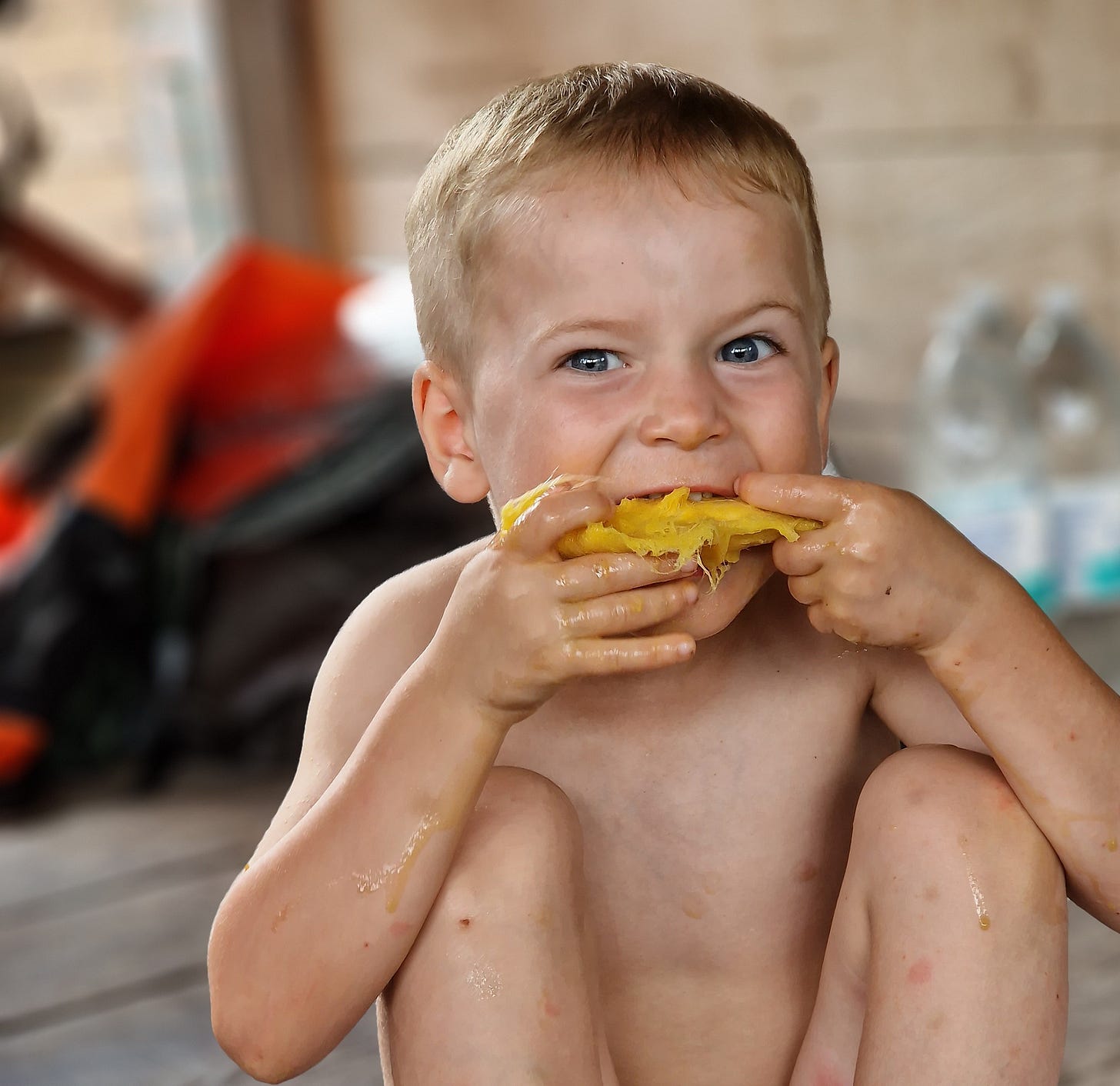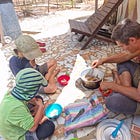How to help your child's teeth grow straight
Our children don’t need to have crooked teeth. Here’s what we can do.
How do you feel about your teeth? And how much did they cost your parents?
I turned away from the conversation for a second. The afternoon sun was sparkling off wavelets on the Indian Ocean. Cut out of the starburst was the black silhouette of my son washing a dead fish in the surf. A bit closer, my husband was gutting and cutting another on the sand. The two girls were in the shade of the hut chopping vegetables to go with the fish. Or so I thought.
A tug on my sleeve. A determined “Mulk”. My thirsty toddler was asking for a feed. Perhaps she had grown bored of onion-peeling duty? My Tanzanian friend looked astonished as I lifted her up. Pre-empting the Western question I expected, I made an excuse. “I know she’s quite big now, but she still likes a bit of milk.”
My friend laughed. “She is not too old! On Mafia island, we breastfeed our babies until they are two and a half. It makes them more clever. But I thought white women don’t give the breast at all? They are scared of getting long titties!”
This explained a lot. Not about the length of Caucasian chesticles you understand, but about the health of the kids on the island. Alongside reduced rates of early malnutrition, on an island with no orthodontists, I was seeing older children with fantastically straight teeth.
Tooth size is genetically determined, jaw size is environmentally determined
Possibly that last link needs some explanation. I should start with what teeth actually are. Teeth are scales - you know, the hard, shiny things that cover most fish and reptiles. Our distant ancestors, some 500 million years ago, realising that they needed something hard to chew up their food, migrated some of their scales into their mouths to do the job. And we’ve had teeth ever since.
Amazingly, that simple paleontology pub-quiz fact has huge ramifications for human health. Why?
Being scales, the size and shape of our teeth are genetically determined. Your parents had big teeth? You’ll have big teeth. And there’s nothing you can do about it.
However, being bone, the size and shape of the jaw is determined not only by our genes, but also by the environment.
(NB. This was a surprise to me too, until I really sat down and thought about it: I knew that leg bones that had been broken would heal and then slowly regain the right shape, moulded by the stresses placed on them by walking. What I hadn't considered is that this isn't a process that only happens after injury - all living bones are continually refining their shapes to give the best balance between strength and weight. In adulthood, this mostly manifests as changing thickness of the bone walls. In childhood, increased use and stress can have a significant effect on eventual bone length).
This mismatch between the growth of tooth and bone is totally invisible under normal mammalian conditions. But in people growing up in modern WEIRD cultures (Western, Educated, Industrialised, Rich, and Democratic)? Not invisible. At all. Very much visible. In my mirror, for example.

My canine teeth came through way too high up. As a tween, I rocked a vampire-chic look, in my tubby, heavily fringed, and thick-glasses way, but with one major difference from the Transylvanian trend-setters: my bite barely worked at all.
I was subjected to five years of orthodontic treatment. When wires, cement, lumps of plastic, and elastic bands failed to haul my wayward teeth into a more aesthetic alignment, they started taking them out to free up space. I still remember blood dripping down my numbed lips after the extractions, and later, the pain as the orthodontist inexorably tightened the wire around my train-track braces.
But despite all of this ‘tooth trouble’, my teeth were completely normal. They were the perfect shape and size. But my jaws had not grown anywhere near enough to hold them. It sounds like some bizarre malformation, doesn't it? A medical curiosity, requiring painful, embarrassing, expensive treatment. One in a million.
This bizarre malformation happens to well over half of children in the UK (by some estimates over 70% throughout Northern Europe). In the US, the average cost of treatment of this malformation is around $5000, and the global market is worth almost $20 billion. How has this happened?
Jaws need to be subjected to the right forces during development
The answer, as I alluded to earlier, is loading.
(NB. the exact mechanism by which loading drives bone growth is fascinating, but I don’t have time to go into it here. If you’re chomping at the bit, to pick a dental metaphor, I've laid out the whole thing in my book, Growing up WEIRD).
Under the normal stresses and strains of a couple of years of breastfeeding, then eating progressively tougher foods, then learning how to crack nuts or peel fruit with your teeth, the bones of the upper and lower jaw grow large enough to fit in all of the teeth, with a small gap in between each and its neighbour for saliva to flow and remineralise damage.
As an important side effect, the lower jaw grows far enough forward that the tongue can lie well out of the way of the airway in the throat, and the upper jaw grows to push the cheekbones and the underside of the eye sockets upwards slightly (which some scientists think may help to improve our vision).
The teeth, sent on their journey outward by nature and then guided to a final location by nurture, end up meeting in a collection of perfect cutting and grinding angles (called ‘good occlusion’ by white-coated professionals).
Eventually, not only are the teeth in a more useful position and less likely to get cavities, but the airway ends up wide open all the way from the nostrils to the voice box. This sets up a whole lifetime of better breathing and biting.
It's easy to understand the cost of this system failing, but I'm not going to retell a familiar tale. Suffice it to say, when the jaws don't grow properly, it's not just a cosmetic issue. Not even close.

Kids’ jaws aren’t loaded sufficiently in Western cultures
So reducing loading enough can make the jaw and tooth sizing system fail. Here are some things that can contribute to that happening:
(NB. I'm aware that our culture makes some of these unavoidable for some of us (myself included). That is unfortunate, but not the end of the world. Think about these as risk factors: the fewer of them a jaw experiences, the more likely a happy outcome).
Bottle feeding - Boobs are heavy! At least they are for a baby trying to lift one with its chin in order to stimulate milk flow. And then there's the hard jaw work of generating suction. And then you have to keep modifying your grip because the woman the beast is attached to (this was originally a typo, but it's too good to edit out) keeps shifting position. And then you have to do it every 15 minutes, day and night, because she's doing a traditional little-and-often regimen with co-sleeping. All together, feeding from a breast is a serious jaw workout.
(NB. Luckily for those of us that can't breastfeed, there are some ways to get similar effects without. I'll explain in a minute. Bear with me).
Kid foods are very soft - Even by our WEIRD standards, the foods we make specifically for kids are particularly soft. Veggie puffs that dissolve into slime with just a lick? White bread with the crusts cut off? What's going on there? Face sabotage, that's what. Especially as young children don’t actually have a natural preference for soft foods.
Pickyness - The other thing that leads to silliness like white-bread-no-crusts is picky eating. I’ve talked about this already in another article. But that's not all it limits. One type of food means one type of texture, and, more often than not, it's something soft.
Part of the reason it's often something soft is that sugar, a major driving force in setting food preferences, is normally added to softer foods.
Tooth decay - The other thing that sugar does to children's faces is make holes in their teeth. Teeth with holes are uncomfortable to use. Can't use your teeth properly? Can’t stress your jaw properly. It's white bread with no crusts for you, my girl!
Added sugar sucks and, after a while, so do the kids that eat it.
Mouth breathing - I’ve talked about this in another article. But upper jaws need support from below to grow forwards and make space. That support is normally provided by the tongue pushing on the hard palate. Thanks to some ethically-questionable experiments on macaque monkeys in the early eighties, we know that, without this pressure, upper jaw bones grow downward rather than forward, and this doesn’t create space for teeth.
And what can drive mouth-breathing? The blocked nose of colds and allergies is a major culprit. When us Northern people are spending the dark months sheltering from the elements in our top-of-the-line shelters, ensuring good ventilation is well down our priorities list. We’re so used to colds and allergies that we barely notice their effects on children’s faces.
Not using the mouth as a tool - We WEIRDos are the ultimate tool users. We've got a tool for everything. Want to peel a vegetable? We've got a peeler. Want to hold a rope for splicing? Use a jig. Want to crack nuts? We've got a whole ballet about the tool for that!
You know what more traditional cultures use as a multi-tool for these three jobs, and more? The mouth. But the specific knowledge you need to use the mouth as a tool without injuring yourself is learned in childhood by watching adults. And we've forgotten how to teach them, so we stop them instead.
OK. So it sounds like most of us in the West, be we parents, or doctors, or policy-makers, or, I guess, school dinner ladies, are put in a situation where we can’t set the children under our care up for correct jaw growth. But don’t panic! There are some things we can do.

But we can improve the odds of grown-enough jaws
So, how do we improve our kids’ jaw growth, no matter where they are in development?
Baby under 6mo?
If you’re lucky enough to be starting at the beginning, make every effort to breastfeed. It doesn’t have to be exclusive, nor does it even have to be much. But do it for as long as you can. If your baby is sad, sick, or tired, the breast is often the best way to improve the situation.
Speaking of which, if your baby takes a pacifier, wean them off it around six months of age. Yes, they’re using their jaw to suck on it, but without any of the normal loading. It’s not going to help and may even make things worse than doing nothing.
Baby over 6mo?
Starting to wean? Give them plenty of hard chewy foods and go easy on the purees. You can read more about the pros and cons of pre-mastication in this article, but for now let me just say that chewing up hard food for a baby and then giving it to them is a great way to get them used to swallowing different textures, which will make it easier for them to enjoy hard foods as soon as their teeth will let them.
Older child?
Keep the nose clear at all costs - see this article for more advice. Help them to learn to keep their mouths shut unless they are talking or eating - see this article for more advice.
Deliberately give chewy and tough foods. I know people who actually make deliberately chewy bread for their young children. If you’re not into baking, leave bread out for a few days to get drier and tougher before you give it to them. Give whole fruit and veg (I’m being literal here. Whole. Not whole pieces. Whole.) to get them opening their mouths and using their jaws at different angles. Make children’s snacks work harder for their health - see this article for more advice.
If you think your kid’s teeth are looking unusual or crooked, you may need to do more. If they sleep with their mouths open, consider helping them to tape their mouths shut (not with Gorilla tape, please, you heathens. They sell specific soft-grip tape for doing this). If they’re not finding enough opportunities to chew, extra tough chewing gum is the current darling of the men-who-want-to-build-their-jaw-muscles-so-they-look-super-pretty market. There are, accordingly, some very expensive and very masculine-aimed gums on the market, with flavours like “Rock” and “Gun”. For the rest of us, Falim is a Turkish supermarket brand and Mastic (also called Mastica) is a natural gum from a Greek tree. Both easy to find online. Both very useful for those empty moments of screen time or car journeys.
Knowing what I now know, I thought I’d see if I could improve my own situation. I spent four months chewing a tough chewing gum for two hours daily to see if I could see any visible effects on the spaces between my teeth. After roughly 250 hours of work, I…could not. However, when my seven-year-old’s teeth looked crowded, she spent two hours a day chewing gum and we could see a visible difference in four weeks. Children are special. Growth is a special time. Before puberty, jaw growth can be stimulated by providing normal loads through eating and breathing. The earlier you act, the bigger the benefit.
We all want children who have comfortable, pain-free faces, but it’s not easy to know what we can do to achieve it. But the benefits of growing a normal-sized face are many, and they will improve a child’s health throughout their whole life.
Want to hear my partner and I discuss our experiences of setting up good jaw growth in children, especially in a child who is at increased risk of crooked teeth? We have a podcast where we use the topic from the previous post and give context and examples to help bring it to life. There’s also a weekly news section where we dive into interesting research into child development from the previous week.
This is the sound of Sunday evenings in our house!
You may also like:
Notes
72% of European children have malocclusion: https://www.ejpd.eu/wp-content/pdf/EJPD_2020_21_2_05.pdf
For Swedish children, ethnicity has very little effect on how likely they are to develop crooked teeth. Genetics clearly don’t play a major role. https://academic.oup.com/ejo/article/29/1/79/539814
Young children don’t have a preference for soft food: https://www.sciencedirect.com/science/article/pii/S0950329323002574
The eating habits of young children affect their jaw and face growth: https://www.mdpi.com/2227-9067/11/2/201







Don't forget about nutrition, though. As Weston A Price noted in his research, it takes animal-based, fat soluble vitamins to grow strong bones and good teeth. All the loading in the world won't help if the building blocks aren't there.
Even so, thank you for bringing this important information to everyone's attention. My (breastfeeding, 19mo) toddler is currently using her teeth to open things and I'm not stopping her. I did a lot with my teeth when I was younger, and all the adults who saw me yelled at me for it, but I did it anyway.
Such a great piece, filled with useful information that is very much outside of the common discourse. I wish I had known this when my child was born, almost as much as I wish my parents knew this when I was born.
I wonder what is your advice for mouth-breathers. I grew up with asthma and have always struggled with allergies, as a consequence my teeth are crowded and nasal breathing is not my default. I've used athletic tape to keep my mouth closed when I sleep, and even bought soft headwear that straps my chin closed. I always rip them off after about an hour because I can't sleep or breath. I practice breathwork daily, and even teach breathwork in school, but sleeping is another matter. I'm frustrated by the energy drain (perceived or real?) and would really like to fix this.
I wonder if you know of any strategies that work?